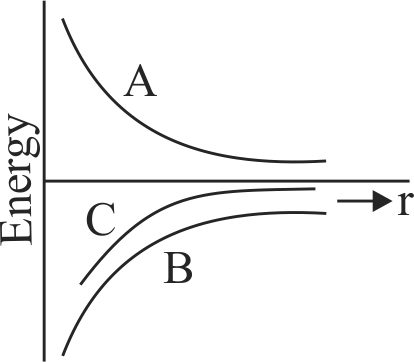359727 A body of mass \(m\) is moving in a circular orbit of radius \(R\) about a planet of mass \(M\). At some instant, it splits into two equal masses. The first mass moves in a circular orbit of radius \(\dfrac{R}{2}\) and the other mass, in a circular orbit of radius \(\dfrac{3 R}{2}\). The difference bewteen the final and initial total energies is:
359731 Two satellites \(P\) and \(Q\) of same mass are revolving near the earth surface in the equitorial plane. The satellite \(P\) moves in the direction of rotation of earth whereas \(Q\) moves in the opposite direction. The ratio of their kinetic energies with respect to a frame attached to earth will be -
359727 A body of mass \(m\) is moving in a circular orbit of radius \(R\) about a planet of mass \(M\). At some instant, it splits into two equal masses. The first mass moves in a circular orbit of radius \(\dfrac{R}{2}\) and the other mass, in a circular orbit of radius \(\dfrac{3 R}{2}\). The difference bewteen the final and initial total energies is:
359731 Two satellites \(P\) and \(Q\) of same mass are revolving near the earth surface in the equitorial plane. The satellite \(P\) moves in the direction of rotation of earth whereas \(Q\) moves in the opposite direction. The ratio of their kinetic energies with respect to a frame attached to earth will be -
359727 A body of mass \(m\) is moving in a circular orbit of radius \(R\) about a planet of mass \(M\). At some instant, it splits into two equal masses. The first mass moves in a circular orbit of radius \(\dfrac{R}{2}\) and the other mass, in a circular orbit of radius \(\dfrac{3 R}{2}\). The difference bewteen the final and initial total energies is:
359731 Two satellites \(P\) and \(Q\) of same mass are revolving near the earth surface in the equitorial plane. The satellite \(P\) moves in the direction of rotation of earth whereas \(Q\) moves in the opposite direction. The ratio of their kinetic energies with respect to a frame attached to earth will be -
359727 A body of mass \(m\) is moving in a circular orbit of radius \(R\) about a planet of mass \(M\). At some instant, it splits into two equal masses. The first mass moves in a circular orbit of radius \(\dfrac{R}{2}\) and the other mass, in a circular orbit of radius \(\dfrac{3 R}{2}\). The difference bewteen the final and initial total energies is:
359731 Two satellites \(P\) and \(Q\) of same mass are revolving near the earth surface in the equitorial plane. The satellite \(P\) moves in the direction of rotation of earth whereas \(Q\) moves in the opposite direction. The ratio of their kinetic energies with respect to a frame attached to earth will be -
359727 A body of mass \(m\) is moving in a circular orbit of radius \(R\) about a planet of mass \(M\). At some instant, it splits into two equal masses. The first mass moves in a circular orbit of radius \(\dfrac{R}{2}\) and the other mass, in a circular orbit of radius \(\dfrac{3 R}{2}\). The difference bewteen the final and initial total energies is:
359731 Two satellites \(P\) and \(Q\) of same mass are revolving near the earth surface in the equitorial plane. The satellite \(P\) moves in the direction of rotation of earth whereas \(Q\) moves in the opposite direction. The ratio of their kinetic energies with respect to a frame attached to earth will be -
